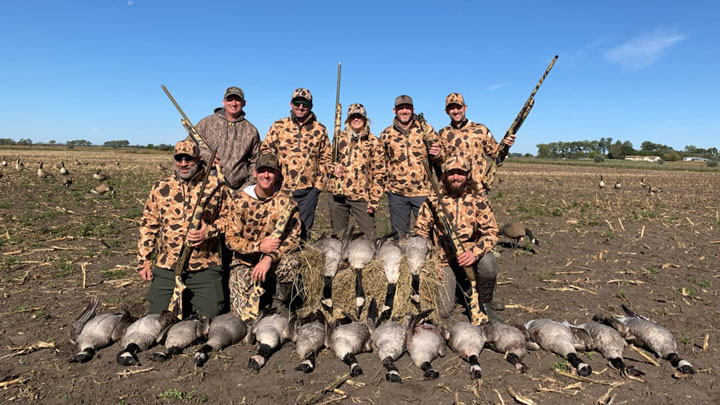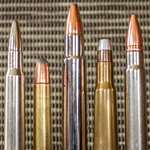
The sun beat down on the South Dakota soil as we sheltered ourselves amongst the cornstalks. Two days into a goose hunt outside of Hecla, South Dakota, we were sweating both figuratively and literally. Unseasonably warm and still conditions had combined with a bright full moon to keep most birds grounded, and uninterested in feeding in sileage fields. Undeterred, however, we knew this would prove almost a better test of our equipment than a banner outing, as on hunts like this, every shot counts.
We came equipped with a variety of gear courtesy of Browning Arms and Ammo. A number of us carried Maxus IIs, decked out in Vintage Tan Camo, while others (like myself) sported new A5s. For ammo, we fired Wicked Blend shotshells. Finally, to top off the trend, Wicked Wing Vintage Tan camo was the order of the day, a choice that blended into the corn rows with uncanny ease.
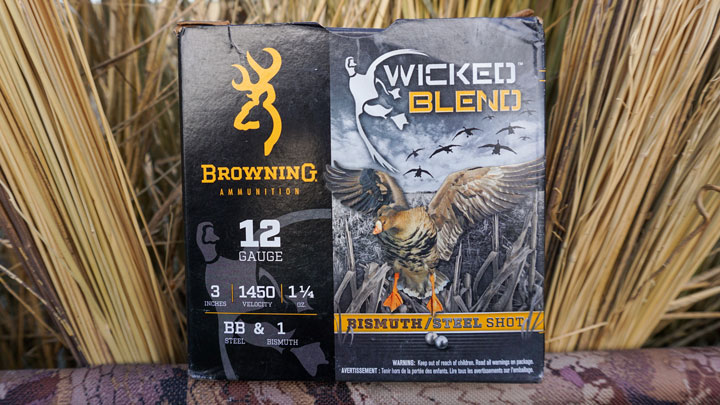
Our outfitter, Alex Russo, owner of Flatland Flyways, scanned the sky for birds as calls blew furiously. An experienced waterfowler, Alex had been working his tail off these last few days to find us geese, with environmental conditions thwarting us at every turn. Thanks to his crafty positioning, we hadn’t quite been skunked yet, but pickings were certainly slim.
Today though, our luck seemed about to turn. We had a hint of wind behind us, and were prepared to make it count. Amidst the wheezing trumpeting of goose calls, we ducked our heads, careful not to flare the triple coming in. “Kill ‘em” commanded Alex, and up we stood, muzzles flashing until the geese lay grounded, dogs sprinting to retrieve them.
As I clicked my safety on and returned my A5 to the floor of the blind, I took a moment to thank my lucky stars that Browning had seen fit to revamp the classic design instead of simply shelving it. I had grown up on humpbacks, and many of the related designs they spawned across the industry, so for me there’s just something reassuring about that familiar, if ungainly profile.
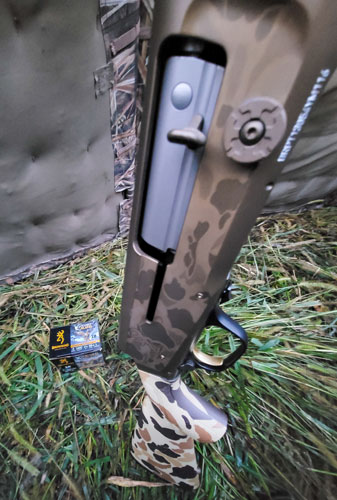
Within its awkward-looking receiver, however, the A5 has brand-new internals reworked around a Kinematic Drive system. While this is a cousin of the sort of recoil operation that powered the original A5, it is a fairly distant one. Now, instead of recoil energy simply slamming the bolt and barrel rearward, an internal spring within the bolt body accumulates enough energy to cycle the bolt, before the bolt head unlocks and utilizes this stored energy to work the action. This makes for a gun that can more reliably run the gamut of ammunition, from 3.5-inch magnums all the way down to 1-ounce field loads (with a 3-inch chamber), rather than having to rely on the more massive recoil generated by harder-hitting shotshells. This allows for load-versatility more akin to a gas gun, while simultaneously keeping things cleaner (as the gas is not returned to the action), lighter, and slimmer. All these features converged in the field, where the gun swung with an ease and pointed with a consistency that proved incredibly dangerous to the health of any geese in its path, the action never once failing to fire and cycle.
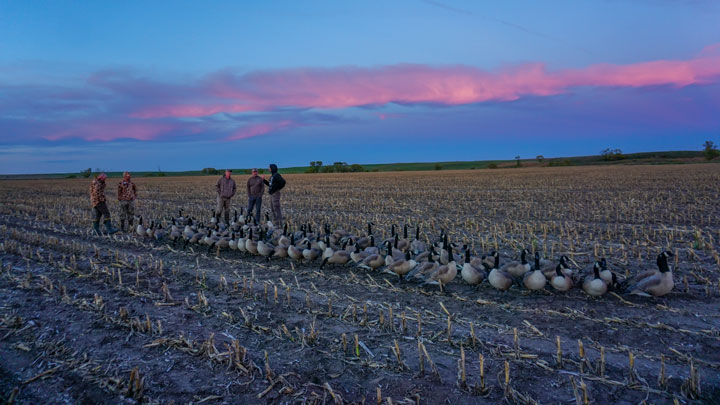
No sooner had I begun to relax onto my seat, when of a sudden, the calls came again. Not a large group, to be sure, but a locked-up double came gliding in, only to be immediately downed by my companions on the left. I didn’t even get a shot off this volley, as their A5s and Maxus IIs made short work of the honkers.

There was yet another factor contributing to such a high success rate this day. Most people don’t think of shotshells as high technology, and to be sure, in a world of iPhones and computer chips, it’s easy to see why. But they’re far from the simplistic, powder-and-pellet designs of yesteryear. Particularly since lead has been phased out for waterfowlers nationwide, shotshells have had to get creative to continue consistently downing birds, and creative is exactly the word to describe the Wicked Blend shotshell.
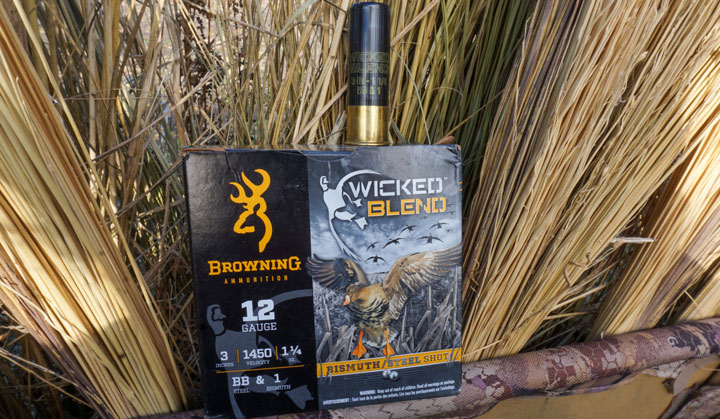
The shells use a 70/30 mixture of BBs and number one bismuth to drop birds with authority (a variant using a 30/70 mix of numbers 2 and 4 bismuth is also available). This alone provides a solid wallop, with excellent energy retention, and a dense formation with a high pellet count. The other trickery that keeps Wicked Blend hard-hitting, reliable and accurate is an even more overlooked component. In keeping with its naming convention, Browning Wicked Blend uses an aerodynamically stabilized Wicked Wad. To its rear, aerodynamic petals stabilize the wad for a straighter flight path. This is designed to decrease any slinging, and actively pulls the wad away from its shot string, instead of just leaving its flightpath to chance. A slotted sidewall promises to improve the response of the payload to chokes and, my personal favorite part, the wad boasts a water-resistant seal to help keep powder dry, even in the worst conditions. While we weren’t exactly able to test out this last bit in the relatively dry South Dakota sileage fields, I can say from experience that the former factors all combined to put the hurt on even tough birds like geese.
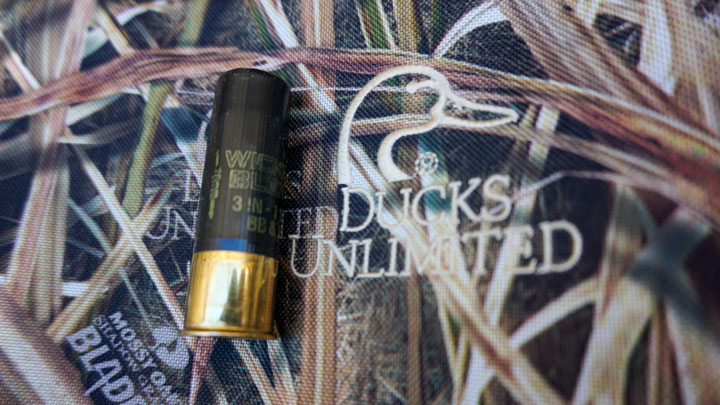
As I turned the shell over in my hand, I felt a little silly, but it was hard not to marvel at the amount of thought that went into this one small component, not to mention the clear difference it made. There was hardly time to ponder the intricacies however, as soon I could hear more geese on the way, and settled back into my position. All told, we felled 18 geese that morning. While not a banner outing for a group our size by any stretch of the imagination, it was a hard-fought bunch, and we were grateful for the success. For the rest of the trip, our luck would return to how it was prior to this morning, with nocturnal, overly warm geese mostly refusing to fly. But before I bring this story to an end, I need to highlight one more clear winner from our time in South Dakota.
While I have a obvious prejudice toward the Kinematic Driven A5, I was given the further opportunity to try Browning’s new Maxus II. The gun is a reliable performer no matter what you’re shooting, or where you’re shooting it, thanks in large part to a Power Drive Gas System. This has the added benefit of reducing felt recoil a good bit—even I would have to say this was the softer shooter of the two. A 1.5-inch Inflex Recoil Pad further helps things on that front. The gun’s Lightning Trigger boasts the fastest lock time of any autoloader in its class, and it was easy to see what a difference this made. Moving from goose to goose with this gun, or even delivering two shots to the same bird, was an incredibly quick proposition. Swing and balance were also on point, thanks to an unusually light weight for a gas gun. Hovering right around 7 pounds, depending on barrel and chamber length, the gun is actually an ounce or so lighter than a comparable A5. For more on the gun’s technical specifications, check out our SundayGunday on the topic here.
